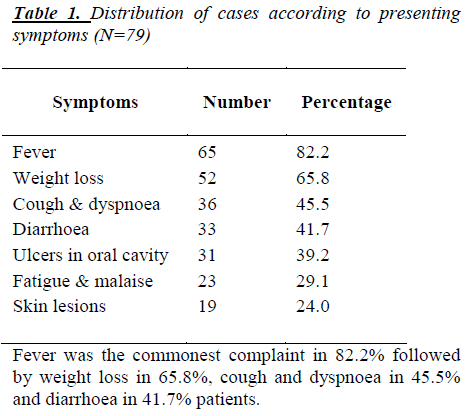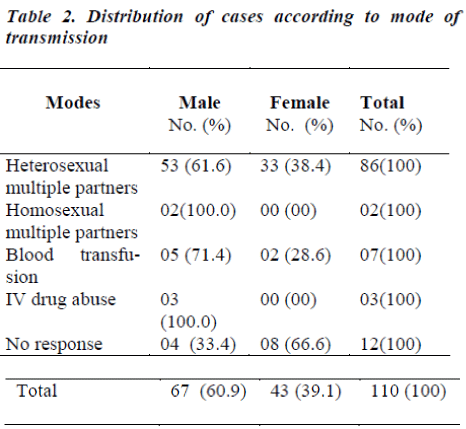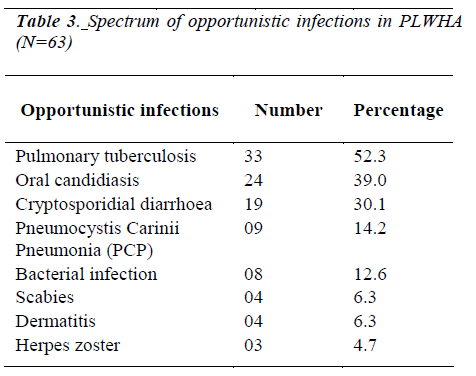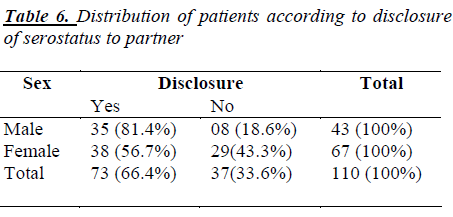- Biomedical Research (2012) Volume 23, Issue 1
Study of Opportunistic Infections In HIV Seropositive Patients Admitted to Community Care centre (CCC), KIMS Narketpally
Anant A. Takalkar*, G.S. Saiprasad, V .G. Prasad and Narendra S. MadhekarDepartment of Community Medicine, Kamineni Institute of Medical Sciences, Narketpally, Nalgonda District, Andhra Pradesh, India
- *Corresponding Author:
- Anant A. Takalkar
Department of Community Medicine
Kamineni Institute of Medical Sciences, Narketpally.
Narketpally- 508254, Nalgonda District
Andhra Pradesh, India
Accepted date: October 21 2011
Abstract
The human immunodeficiency virus (HIV) infection leading to Acquired Immunodeficiency Syndrome (AIDS) causes progressive decline in immunological response in people living with HIV/AIDS (PLWHA) making them susceptible to a variety of and opportunistic infections which are responsible for morbidity and mortality. Community Care Centres (CCC) have been started as a measure to ensure compliance of antiretroviral treatment. Detailed history taking, clinical examination and laboratory tests were carried out in 110 patients. The pattern of opportunistic infections in people living with HIV/AIDS (PLWHA) attending CC was studied. The presenting symptoms were fever (82.2%), weight loss (65.8%), cough & dyspnoea (45.5%) and diarrhoea (41.7%). One or more opportunistic infections were observed in 63 patients (57%). Commonly observed were pulmonary tuberculosis (52.3%), candidiasis (39%), cryptosporidial diarrhoea (30.1%) and Pneumocystis Carinii Pneumonia (PCP) (14.2%). In 46.4% of cases CD4 count was less than 200. Findings point to the importance of early diagnosis and treatment of opportunistic infections in order to improve quality and expectancy of life.
Keywords
Symptoms, Opportunistic infections, HIV/AIDS
Introduction
HIV infection continues to be a major public health problem with worldwide 40 million and estimated 3.6 million PLWHA in SEAR [1,2]. The first case of AIDS in India was reported in 1986 and now India is a country with the second largest population of HIV infected individuals [1]. India has an estimated 2.3 million (1.8 to 2.9) HIV positive persons in 2007 with an adult HIV prevalence of 0.36% (0.25-0.43%). Sexual route continues to be major mode of transmission though injectable drug use is also emerging as an important mode of transmission in some parts of the country.
According to 2001 census, with 76.2 million population, Andhra Pradesh is India’s fifth most populous state and considered as one of the six high prevalent states. Certain socioeconomic factors contribute to vulnerability of state to this epidemic. These factors are not only promoting commercial sex work but also playing an important role in occurrence of opportunistic infections in PLWHA. Nalgonda district has prevalence of 1.88 % amongst antenatal mothers [3].
National AIDS Control Programme Phase III (2007-2012) has overall goal of halting and reversing epidemic in India over 5 year period with high priority of preventive efforts and establishment of Community Care Centres (CCC) for providing treatment, care and support to PLHA and ensures that PLWHA are provided with (i) counseling for ART adherence; (ii) treatment of opportunistic infections; (iii) referral and outreach activities for follow up and (iv) social support services. As of 31st March 2009, a total 254 CCC were operational. [4]
Patients with HIV are prone to develop a panorama of disease during their lifetime. Because of progressive decline in immune response, these patients are extremely susceptible to variety of common as well as opportunistic infections. Therefore this study was aimed at assessing the clinical profile with respect to presenting symptoms and common opportunistic infections in HIV positive patients admitted to CCC of KIMS Narketpally for investigation, counseling for drug adherence and treatment of opportunistic infections.
Materials and Methods
The present cross-sectional hospital based study was conducted amongst 110 people living with HIV/AIDS (PLWHA) at Community Care Centre of KIMS.
All new seropositive HIV cases admitted during October 2008 to January 2009 (4 months) were studied. Only new registered cases during above period were included. Detailed history, clinical examination and investigations (sputum examination, stool examination and CD4) were done with standard procedures and data thus collected were recorded by using structured proforma.
Results
Out of 110 cases, 60.9% were males and 39.1% females. 77.2% of patients were in 26-45 years age, the sexually active age group. Distribution of cases as per presenting symptoms is shown in table 1. In 79(71.8%) patients commonly observed symptoms were fever (82.2%), followed by weight loss (65.8%), cough and dyspnoea (45.5%), diarrhea (41.7%) and ulcers in orophyrangeal cavity (39.2%).
Distribution by mode of transmission is shown in table 2. In 98 cases (80%) the predominant mode of transmission was sexual route of which 78.2% were heterosexuals with multiple partners. Remaining 20% did not respond to the question on pattern risk behaviour followed.
Pattern of the opportunistic infections is given in table 3 and its comparison with various other studies in table 4. One or more opportunistic infections were observed in 63 patients (57%).Commonly observed opportunistic infections were pulmonary tuberculosis (52.3%), candidiasis (39%), cryptosporidial diarrhea (30.1%) and PCP (14.2%). In 46.4% cases CD4 count was less than 200. Association between opportunistic infection and level of CD4 count was found to be statistically significant (p< 0.05) in table 5. Overall outcome of serostatus disclosure was found to be positive with disclosure rate of 66.4% in Table 6.
Having Heterosexual multiple partners was the commonly observed mode of transmission in 61.6% males and 38.4% females. In 71.4% males, infection was acquired through blood transfusion.
Incidence of pulmonary tuberculosis was the highest (52.3%), followed by oral candidiasis (39.0%), cryptosporidial diarrhoea (30.1%) and PCP (14.2%). Commonly observed skin OI were bacterial infections (12.6%), scabies and dermatitis (6.3% each).
CD4 count less than 200 mm3 observed in 46.4% cases. Of which 70.5% patients had one or other opportunistic infections. The prevalence of opportunistic infection is more at reduced CD4 count and the association between opportunistic infection and level of CD4 count was found to be statistically significant (p< 0.05)
81.4% male patients and 56.7% female patients had disclosed their serostatus to their spouse. So disclosure rate observed was 66.4%
Discussion
Fever (82.2%), weight loss (65.8%), cough and dyspnoea (45.5%), diarrhea (41.7%) and ulcers in orophyrangeal cavity (39.2%) were the major symptoms observed. Our findings are almost similar with study results of Pandey S et al [5], Zaheer MS et al [6] and Mahajan A et al [7] and Wadhava A et al [8]. However, Joshi HS et al [9] observed fever in 48.6%, cough in 36.4% and weight loss in 58.8% of cases which are lower than those observed in the present study. Higher incidence of tuberculosis in the present study (52.3%) could be the reason for high proportion of cough, fever, and weight loss as presenting symptoms and was comparable to other Indian studies [6]. Thus fever, weight loss and cough were common symptoms seen in PLWHA. Epidemiological features depend upon social and cultural practices of the people which may again vary from region to region [10].
Heterosexual contact continued to be the commonest mode of transmission and consistent with findings by others [4,9,10,11]. Commonest source of contact was Commercial Sex Workers (CSWs).This shows that inspite of intense condom promotion by National AIDS Control Organisation (NACO), the message had not effectively reached to masses.
Tuberculosis was commonest observed opportunistic infection in our study and matches with findings by other authors [5,6,11,14]. This is because tuberculosis is endemic in India and patients with HIV and TB rapidly downgrade with high mortality and multidrug resistance. In case of candidial infection, our study findings are comparable with findings of Shobhana A et al [12]. Comparatively low incidence of candidiasis was observed in studies by others [5,10,11,13]. Oral candidiasis was the commonest mucocutaneous opportunistic infection observed in our study.
Findings of cryptosporidial diarrhoea was almost comparable with other studies [14], where as Mulla SA [13] reported low incidence. Relatively high incidence of oral candidiasis and diarrhoea may be due to low socioeconomic status, poor hygiene and non-availability of safe drinking water. High prevalence of PCP was observed as compared with other studies [5,14]. PCP occurs in advanced HIV disease generally with CD4 count less than 200 cells/mm3. In our study more than half patients with opportunistic infection were having CD4 count less than 200 cells/mm3. Similar findings regarding herpes zoster and scabies were observed by Pandey S [5] and Shobhana A et al [12]. Our findings of having CD4 count less than 200 in 46.3% of cases is similar to the findings of Mahajan A et al [7]. Teja VD et al [15] found in 66.3% of patients the CD4 count to be less than 200; however this was at the time of death of the patients. The overall outcome of serostatus disclosure was found to be positive (66.4%). However 33.6% of people living with HIV/AIDS (PLWHA) had not disclosed their HIV status. The positive outcome can be attributed to familistic orientation of Indian society and spread of awareness about HIV/AIDS which can be managed by mutual understandings amongst couple. This is in continuation with study conducted in Mumbai [16].
The pattern of Opportunistic infections in a particular area helps the attending physicians to be on the look out for them and take prompt therapeutic measures. Simultaneously specific health education of PLWHA regarding early detection of opportunistic infection (OI) and importance of antimicrobial prophylaxis to reduce the morbidity and mortality can be undertaken.
References
- Marfatia YS, Sharma A, Modi M. Overview of HIV/AIDS in India. Indian J sex Transm Dis 2007; 28: 1-5.
- HIV/AIDS burden Global & SEAR, World AIDS Day 2008 (Available from www.who.int, last accessed on 08.10.2009)
- Facts, figures and Response to HIV/AIDS in Andhra Pradesh (Available from www.apsacs.org. Cited on 08.10.2009)
- UNGASS Country Progress Report India 2008, Na- tional Aids Control Organization, Ministry of Health & Family Welfare, Government of India, New Delhi.- (Available from http://data.unaids.org/pub/Report/ 2008/ India 2008 country progress _ report _en. pdf. Accessed on 08.10.2009)
- Pande S, Sunder S, Hasan H, Shankar R,Singh SP. Clinical profile and opportunistic infection in HIV/- AIDS patients attending S.S.hospital, Varanasi. Indian J Prev. Soc. Med.2008; 39:1-2.
- Zaheer MS, Rabbani MU, Ahmed Z, Khan T, Rewari BB, Pandey DK. Clinical demographic profile of pa- tients in and around Aligarh. J Ind Acad Clin Med 2003;4 (2):121-126
- Mahajan A, Tandon VR,Verma S, Singh JB, Sharma M. Prevalence of tuberculosis, hepatitis B, hepatitis C and coinfections among HIV/AIDS patients. Indian Journal of Medical Microbiology 2008;26 (2):196-207.
- Wadhwa A, Kaur R, Agarwal SK, Jain S, Bhalla P. AIDS-related opportunistic mycoses seen in a tertiary care hospital in North India. Journal of Medical Micro- biology 2007; 56, 1101-1106
- Joshi HS, Das R, Agnihotri AK. Clinico-epidemiolo- gical profile of HIV/AIDS patients in Western Nepal-a study from teaching hospital. Indian Journal of Preven- tive and Social Medicine 2004; 35 (1-2): 69-76.
- Nair SP, Moorthy KP, Suprasakan S. Clinico-epidemi- ological study of HIV patients in Trivendrum. Indian J Dermatol Venerol Leprol 2003; 69: 100-103.
- Ayyagari A, Sharma AK, Prasad KN et al. Spectrum of opportunistic infections in HIV infected cases in a terti- ary care hospital. Indian J Med Microbiol1999; 17: 78- 80.
- Shobhana A, Guha SK, Neogi DK. Mucocutaneous manifestations of HIV infection. Indian J Dermatol Ve- nerol Leprol 2004; 70 (2): 82-86.
- Mulla SA, Patel MG, Motala N, Desai V, Shrivastava RK. A study of opportunistic infection in HIV sero- positive patients. Indian Journal of community Medi- cine 2007; 32 (3): 208-209.
- Singh A, Bairy I, Shivanand PG. Spectrum of oppor- tunistic infections in AIDS cases. indian J Med Sci 2003; 57: 16-21.
- Teja VD, Sudha T, Lakshmi V. cases and pattern of mortality in HIV-infected, hospitalized patients in a ter- tiary care hospital: A fourteen year study. Indian J Med Sci 2007; 61(10): 555-561.
- Bhagat S, Facing the challenge - Household and Com- munity Response to HIV/AIDS in Mumbai, India. HIV/AIDS Research in India, NACO: New Delhi; 1997.





